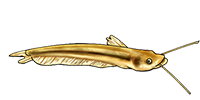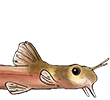Hardman, M & LM Hardman, 2008. The relative importance of body size and paleoclimatic change as explanatory variables influencing lineage diversification rate: an evolutionary analysis of bullhead catfishes (Siluriformes: Ictaluridae). Systematic Biology 57: 116–130.
Abstract
We applied Bayesian phylogenetics, divergence time estimation, diversification pattern analysis, and parsimony-based methods of ancestral state reconstruction to a combination of nucleotide sequences, maximum body sizes, fossils, and paleoclimate data to explore the influence of an extrinsic (climate change) and an intrinsic (maximum body size) factor on diversification rates in a North American clade of catfishes (Ictaluridae). We found diversification rate to have been significantly variable over time, with significant (or nearly significant) rate increases in the early history of Noturus. Though the latter coincided closely with a period of dramatic climate change at the Eocene-Oligocene boundary, we did not detect evidence for a general association between climate change and diversification rate during the entire history of Ictaluridae. Within Ictaluridae, small body size was found to be a near significant predictor of species richness. Morphological stasis of several species appears to be a consequence of a homoplastic increase in body size. We estimated the maximum standard length of the ictalurid ancestor to be approximately 50 cm, comparable to Eocene ictalurids (Astephus) and similar to modern sizes of Ameiurus and their Asian sister-taxon Cranoglanis. During the late Paleocene and early Eocene, the ictalurid ancestor diversified into the lineages represented by the modern epigean genera. The majority of modern species originated in the Oligocene and Miocene, most likely according to a peripheral isolates model of speciation. We discuss the difficulties of detecting macroevolutionary patterns within a lineage history and encourage the scrutiny of the terminal Eocene climatic event as a direct promoter of diversification.
Paleoclimate, body size and ictalurid evolution
- Silurus
- Posts: 12469
- Joined: 31 Dec 2002, 11:35
- I've donated: $12.00!
- My articles: 55
- My images: 902
- My catfish: 1
- My cats species list: 90 (i:1, k:0)
- Spotted: 432
- Location 1: Singapore
- Location 2: Moderator Emeritus





